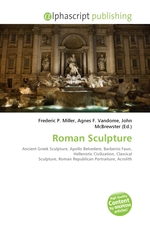Roman Sculpture
Frederic P. Miller, Agnes F. Vandome, John McBrewster
бумажная книга
High Quality Content by WIKIPEDIA articles! The study of Roman sculpture is complicated by its relation to Greek sculpture. Many examples of even the most famous Greek sculptures, such as the Apollo Belvedere and Barberini Faun, are known only from Roman Imperial or Hellenistic "copies." At one time, this imitation was taken by art historians as indicating a narrowness of the Roman artistic imagination, but in the late 20th-century, Roman art began to be reevaluated on its own terms: some impressions of the nature of Greek sculpture may in fact be based on Roman artistry. Much of what is known comes from survivals, and the commentary of Pliny the Elder in his Naturalis Historia. Much Roman sculpture survives, but often in damaged or fragmentary form. Portraiture is a dominant genre, growing perhaps from the traditional Roman emphasis on family and ancestors, as the entrance hall (atrium) of a Roman elite house displayed ancestral portrait busts. During the Roman Republic, it was considered a sign of character not to gloss over physical imperfections, and to depict men in particular as rugged and unconcerned with vanity: the portrait was a map of experience.
Данное издание не является оригинальным. Книга печатается по технологии принт-он-деманд после получения заказа.


